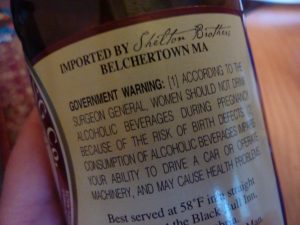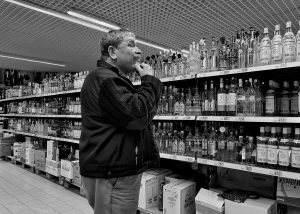Hello readers! I am currently on my maternity leave spending some quality time with my family! Enjoy this guest post from today’s featured author!
The following is a guest post by David Morrison. Morrison grew up in Australia. He eventually acquired a PhD degree in plant biology, during which he became interested in wine. He started visiting wineries throughout Australia, just at the time when high-quality wineries were beginning to boom. Somewhere along the line he moved to Sweden, and in his semi-retirement he runs a blog called The Wine Gourd (winegourd.blogspot.com). In the interests of doing something different to every other wine blogger, this blog delves into the world of wine data, instead. He is particularly interested in the relationship of wine quality to price, and quantifying value-for-money wines.
Back in September, the World Health Organization released its Global Status Report on Alcohol and Health 2018. The associated press statement noted:
More than 3 million people died as a result of harmful use of alcohol in 2016, according to a report released by the World Health Organization (WHO) today. This represents 1 in 20 deaths. More than three quarters of these deaths were among men. Overall, the harmful use of alcohol causes more than 5% of the global disease burden.
It is thus not surprising that governments are becoming increasingly concerned about the negative effects of alcohol on human health, what we would call alcohol abuse. For example, warning labels advising pregnant women about the dangers of drinking alcohol are soon to become mandatory in New Zealand and Australia. Even more seriously, Ireland is set to introduce general warnings for all drinkers, notably with cancer warnings on labels (and Scotland is thinking of doing the same). Furthermore, it is repeatedly reported that alcohol consumption is decreasing in those countries where it has traditionally been the highest,

Photo courtesy Flickr user Andrew Bowden
indicating that the populace in general might not be all that convinced about their consumption of something that the medical industry classifies as an addictive drug.
On the other hand, there has also been strong resistance to these moves from within the alcohol industry. The resistance has been to the warning labels, but also especially to increased taxes that are intended to curb excessive drinking. This attitude might conceivably be an example of burying one’s head in the sand, because it seems to contradict any claim by the alcohol industry that they are a socially responsible industry.
There has been much discussion about the alcohol industry this year in the highly regarded British Medical Journal (BMJ). This is because 10 years ago the British government decided on an alcohol control policy centered around a partnership with the alcohol drinks industry, and this approach has remained controversial. To quote a BMJ editorial from February this year:
The United Kingdom has been anything but united about how to deal with the nation’s alcohol problems. While some people have seen collaboration with industry as a way of “disabling the public interest,” the ostensible rationale was to involve alcohol producers and retailers in new initiatives — such as voluntary limits on advertising, safer packaging, and codes of good conduct — to make town centres safer at night. In response to mounting evidence that this approach is not working, this week the BMA [British Medical Association] voices its opinion on how the problem should be tackled …
In September, the UK government launched a health promotion partnership between Public Health England, an executive branch of the Department for Health and Social Care, and Drinkaware, an organization funded by the alcohol industry. This occasioned another editorial, along with commentary, entitled: Public Health England’s capture by the alcohol industry.
This means that it is high time for some quantitative evaluation of the alcohol industry’s track record of social responsibility. A study published in October in the BMJ has tried to do precisely that: Is the alcohol industry doing well by ‘doing good’? Findings from a content analysis of the alcohol industry’s actions to reduce harmful drinking.
Here is a summary of the study, compiled from various parts of the paper, arranged as in the research article:
Objectives:

Photo courtesy Pixabay
The aims of this study were to: (1) describe alcohol industry corporate social responsibility (CSR) actions conducted across six global geographic regions; (2) identify the benefits accruing to the industry (called ‘doing well’); and (3) estimate the public health impact of the actions (called ‘doing good’).
Setting of the study:
Industry actions undertaken in the six geographic regions were examined using a web-based compendium, the International Alliance for Responsible Drinking database, issued in 2012. This described 3,551 industry actions, representing the efforts of the alcohol industry to reduce harmful alcohol use.. The compendium consisted of short descriptions of each action, plus other information about the sponsorship, content and evaluation of the activities. This database is likely to be comprehensive, and representative of the alcohol industry’s CSR activities, covering the years 1990 to 2014.
Participants:
From 2014 to 2016, public health professionals (n=19) from South America, the USA, the European Union and Australia evaluated a sample (n=1,046) of the actions using a reliable content rating procedure, based on what is called evidence benchmarking. All of the evaluators were initially trained to an acceptable level of reliability; but the authors could not rule out differential bias in the raters recruited from different regions.
Outcome measures:
Identification of the World Health Organization global strategy area in which the industry action took place, along with estimating the population reach, the risk of harm, the advertising potential, the policy impact potential, and other aspects of the activity. The authors were unable to determine whether the industry actions represented significant charitable contributions, or were merely activities that in some cases would have been conducted anyway (e.g. those required by law).
Results:
The industry actions were found to be conducted disproportionately in regions with high-income countries (Europe and North America), with lower proportions in Latin America, Africa and Asia. Only 27% of the actions conformed to recommended WHO target areas for global action to reduce the harmful use of alcohol. The overwhelming majority (96.8%) of industry actions lacked scientific support (p<0.01), and 11.0% had the potential for doing harm. The benefits accruing to the industry (‘doing well’) included brand marketing, and the use of CSR to manage risk and achieve strategic goals.
Conclusion:
Alcohol industry CSR activities are considered unlikely to reduce harmful alcohol use, but they do provide commercial strategic advantage, while at the same time appearing to have a public health purpose.
In public comments on this study, and on the British government’s alliance with the alcohol industry, the senior author, Thomas Babor (from the University of Connecticut School of Medicine), noted:
The corporate social responsibility activities of alcohol producers conceal a clear conflict of interest in improving public health, as a truly effective approach to tackling alcohol harm will only hurt their bottom line. Governments, however, have a clear duty to put public health first, and must do so without industry interference.
Comments
Clearly, this is a descriptive study, rather than an experiment, in that it used a pre-existing database as the source of information. In order to accept the conclusions of this study, we need to accept the ideas that: (i) the database was comprehensive and accurate, with enough information for evaluation of the key information; and (ii) the evaluators were effective and thorough in extracting and evaluating the information.

Photo courtesy Flickr user Sergei F
The database was apparently the only reliable source available, until it was “shut down without explanation in April 2016” — this action seems to have terminated the study! The researchers went to considerable trouble to validate their choice of sample size and sampling procedure, which are the two major issues for this type of study.
Multiple evaluators are required for this work, and they need to be trained, to ensure consistency. Ideally, each piece of information would be evaluated by several people, to test for consistency. However, in this case, subsets of information were rated by all of the participants during initial workshops, and discussed until a consensus was reached. This is a reasonable alternative approach.
So, it seems that this study is as good as we likely to get, in terms of studying the actions of the alcohol industry with regard to “corporate social responsibility”. In which case we can consider the conclusions to be realistic, and therefore pretty damning.
If we accept the outcomes of this research, then the alcohol industry is not taking the situation seriously enough. This seems to be a well-designed and well-executed study, which actually slams the industry as being consistently irresponsible worldwide in dealing with alcohol abuse, over 2.5 decades. There needs to be a much more serious attempt by the various trade bodies, such as the Distilled Spirits Council of the United States, the Wine and Spirit Trade Association (UK), SpiritsEurope, European Federation of Origin Wines, the Winemakers Federation of Australia, etc, etc.
I remember the time in Australia, several decades ago, when the inter-state truckers were arguing with the federal government about new laws that were being introduced, which regulated their industry and restricted their behavior (speed limits, driving time, length of breaks, etc). They claimed that they could be trusted to behave responsibly. In the middle of this discussion, an inter-state bus drifted across the center-line of a major highway, into the oncoming traffic. This traffic consisted of another inter-state bus, coming the other way at the same speed. The aerial photos of two large buses buried deeply inside each other, along with the knowledge that the passengers were buried a few days later, destroyed any arguments that the truckers may have had about being allowed to regulate themselves. The ensuing laws were even more draconian than they had feared.
Is the alcohol industry heading for a similar bus crash? I wouldn’t be surprised. After all, a “bus crash” is not just a metaphor — people die from alcohol as well as from vehicles, as the recent WHO report emphasizes. It looks like the alcohol industry may be in for a rough time, if they continue to argue for self-regulation, without any tangible evidence that the outcomes will satisfy society’s needs. Prohibition did not work in the USA, but that is not the only way for governments to dealiwith problems associated with alcohol consumption. Governments have control of taxation, and also of labeling laws, drinking ages, retail sales, and so on. An increasing number of governments seem quite determined to use these powers to regulate the industry, if it won’t regulate itself.
Sources, available free online:
